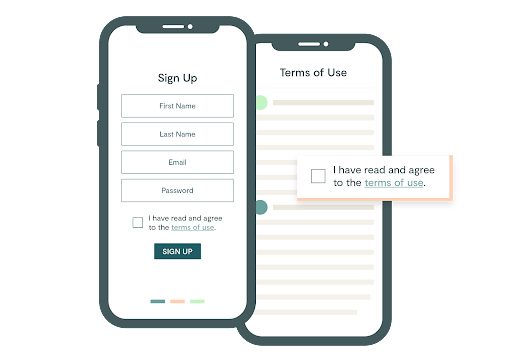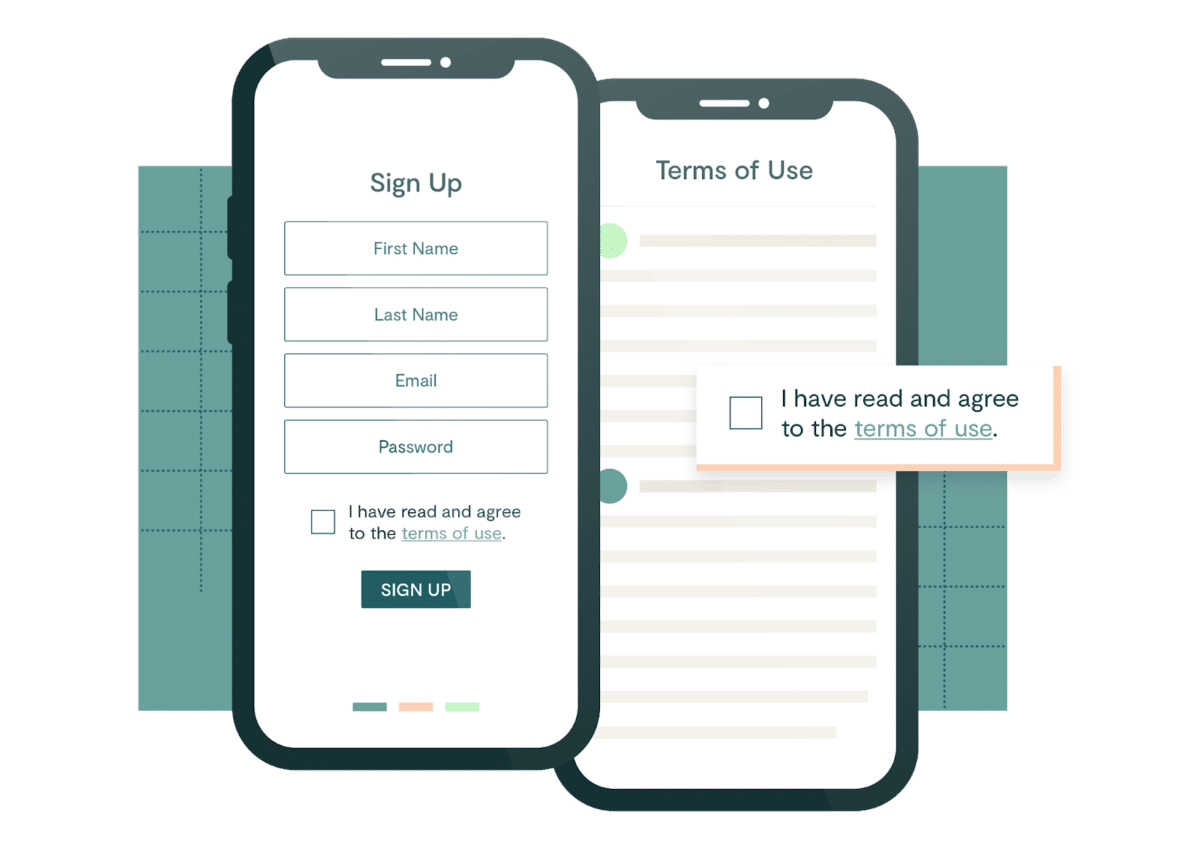Clickwrap agreements are powerful tools for legal departments. They allow us to streamline contract acceptance for standardized agreements by interacting with users where they are – on our webpages. They also enable us to create a frictionless experience for the user while simultaneously creating binding and enforceable agreements.
Implementing clickwrap agreements requires a different approach compared to traditional electronic signatures. Though clickwrap agreements are a type of electronic signature, they are not sent to the user via email to sign. Instead, the user accepts the terms of an agreement by clicking a button or checking a box directly on a webpage.
Traditional electronic signatures remain fully in the control of the legal department, as that department uses an electronic signature provider to send documents via email to be signed. Clickwrap agreements, on the other hand, require a unique partnership between legal and product/engineering teams to embed the clickwrap agreement directly onto a webpage.
This partnership can be novel for many companies looking to implement a clickwrap agreement for the first time. To illustrate what that partnership can look like and how the legal team might navigate that relationship using Ironclad, we’ll walk through how our legal team recently partnered with the product and engineering team to implement a clickwrap agreement.
Implementation Challenges
Several months ago, Ironclad launched Free Trial, which gives you a 14-day free trial of Ironclad CLM. I needed to add a clickwrap agreement to the sign-up page so that all free trial users agree to our Free Trial License Agreement, Terms of Service, and Privacy Policy.
Doing so required initiating and navigating a partnership with product engineering teams, which came with its own set of challenges and questions like:
- Where do I start?
- Who do I reach out to?
- How much time will this take?
- How can I get this project added to an engineer’s already-full plate?
- How can I set the engineer up for quick and easy implementation success?
- Will I have to start this process all over again each time I need to make an edit to the clickwrapped terms?
How We Made It Work
First, I logged into Ironclad Clickwrap and created a template for the Free Trial License Agreement. I then created a Free Trial clickwrap group, adding the Free Trial License Agreement, Terms of Service, and Privacy Policy to the group. I selected how I wanted the clickwrap to be presented to users (I like using a combined checkbox for all templates) and drafted the acceptance language I wanted displayed on the screen to users, shown below:
I then published my clickwrap group. This whole process took me 10-15 minutes at most.
Plan Ahead
Next, I reached out to the webpage owner and let him know that the clickwrap group was set up in Ironclad Clickwrap. Knowing whom to loop in at this step can be a challenge and may take some digging. Sometimes the marketing team owns the webpage, while other times product or engineering teams own the webpage. If the owner of a webpage is an engineer, it’s easiest to have that engineer implement the clickwrap agreement. If the owner is not an engineer, you’ll need to work with the webpage owner to determine which engineer is in the best position to assist with implementation.
In any event, an engineer must be looped in, as the clickwrap agreement is embedded through JavaScript on the webpage. But finding engineer time can be difficult, as they often plan their work out months in advance. The best way to get ahead of this issue is to be looped in early on in the process – the sooner you know about a new product offering or the creation of a new webpage that will require a clickwrap agreement, the sooner you can set it up and have it ready and waiting when the time is right for implementation. This way, clickwrap implementation takes place at the same time the webpage is set up; it becomes part of the process rather than an afterthought that disrupts a product or project that has already been launched. Ironclad has always had a culture of looping legal in early, which I appreciate.
Simple Implementation
In this case, a member of the engineering team owned the webpage, so I let him know when the clickwrap group was set up and what it was called so he could find it in the application. Ironclad Clickwrap contains code snippets and guides directly in the clickwrap group page in the application to guide the engineer through the implementation process. Free Trial does not require any additional navigation to get to the clickwrap agreement (the clickwrap agreement can be seen immediately upon loading the webpage), so implementation was easy. Web pages that require navigation to reach the clickwrap agreement (e.g., you have to click a button before the clickwrap agreement appears) are more complex and take a bit longer to implement as the engineer has to work through the navigation element.
For simple screens, technical implementation of a clickwrap agreement can take up to a few hours. For more complicated screens that require navigation to the clickwrap agreement, implementation can take a few days. An engineer’s familiarity with Ironclad’s clickwrap product also comes into play – an engineer’s first time implementing a clickwrap agreement takes longer than subsequent implementations, understandably.
Record Evidence with Snapshots
Snapshots capture visual evidence of your agreement being signed whether on a desktop browser, mobile browser, or any native application. These screenshots are then stored in a repository for easy reference. After the engineer completed the clickwrap agreement implementation, I set up a snapshot for the web page in Ironclad Clickwrap. For that, I created a new snapshot, entered the Free Trial URL, set up a cadence (weekly in this case), and published the snapshot. This was an easy snapshot to set up. Snapshots (like clickwrap agreements) get a little bit more complicated when navigation is required to get to the clickwrap agreement. But Ironclad Clickwrap’s command builder tool makes it easy for non-engineers to set up snapshots with minimal-to-no engineer involvement.
Outsized Impact
With the Free Trial at Ironclad, terms need to be constantly updated as we’re always adding features or changing what’s included in the free trial. What would otherwise be a pain for legal to update each time is now a breeze with clickwrap. Once the clickwrap agreement is set up and embedded on a webpage, the legal team remains in control of the agreement. I can make changes to the agreement text by editing the template in Ironclad Clickwrap. I can update the agreement language for the clickwrap group in Ironclad Clickwrap, and the change gets pushed out to the webpage as soon as I publish it. Based on settings I select when creating the clickwrap group, users will be prompted to re-accept the clickwrap when I make a major change to any of the templates. Once the clickwrap agreement is implemented, I don’t need to enlist engineer help for future changes.
Clickwrap agreement implementation requires a strong partnership between legal and product and engineering teams. Foster that relationship so that legal is involved early on in the process of launching a new product or initiative.
Sign up for a free custom demo and see what Ironclad Clickwrap can do for your business.
Ironclad is not a law firm, and this post does not constitute or contain legal advice. To evaluate the accuracy, sufficiency, or reliability of the ideas and guidance reflected here, or the applicability of these materials to your business, you should consult with a licensed attorney. Use of and access to any of the resources contained within Ironclad’s site do not create an attorney-client relationship between the user and Ironclad.




